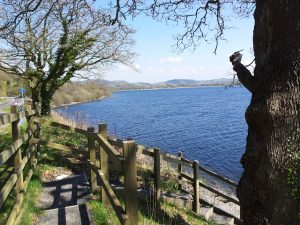Dogs And Clifftop Dangers.
Sadly, there have been numerous occurrences of dogs falling from cliff edges across Britain. Many have been seriously injured and a few have tragically, some have died. Holidays4Dogs finds out more about dogs and the dangers of clifftops. Read on for tips and advice for keeping your dog safe along coastal cliffs.
There are miles and miles of wonderful coastal walks around the UK. However, many of these areas can be quite treacherous for people and animals. There are many dangers to be aware of when walking along these stunning, but sometimes hazardous, coastal areas.
Many footpaths are very steep and narrow, dropping down drastically onto rocky outcrops. While the views can be striking for us to drink in, it can be a very real danger for dogs – especially when they are running free.
Accidents can happen.
In October 2023, a miniature dachshund survived a 40-foot fall after chasing rabbits up a clifftop in Bridlington, East Riding. The coastguard was called because Nellie just could not be found. In her attempt to rescue the pup named Nellie, owner Jacqui Darrington, also got stuck on the cliff face.
The dog sustained injuries including, a fractured shoulder blade and rib damage. Thankfully, she made a full recovery.
There are lots of other similar incidents each year across the UK. This includes dogs chasing livestock over the edge of clifftops, all of which highlight the fact that owners need to be more aware of the dangers when walking their dogs in these areas.
Coastguard rescue.
The coastguard’s priority is to save human lives and while they will save animals if they are in difficulty, they can only really do this if conditions are favourable. They advise against owners trying to rescue dogs themselves, as this could put them at serious risk too.
In 2015, one woman walking her dogs along the edge of a Dorset beauty spot, plunged 100 feet over the cliff face. Miraculously, she survived the fall with only minor back injuries. However, she had been trying to save one of her dogs that had got into difficulty on the cliff edge.
Blind chases.
High-energy dogs, such as hunting dogs, are often at greater risk of falling from cliff-top paths, especially if they are following a scent. Some dogs have a penchant for chasing birds, or rabbits, that spring unexpectedly from the undergrowth.
However, this can often lead them quickly off a cliff edge. Potential injuries from falling from such treacherous heights vary from cuts and bruises to fractured limbs.
More seriously dogs can suffer major trauma such as punctured lungs and sometimes, may die as a result of falling from a clifftop. The dangers of clifftops are a very real hazard to off-lead dogs.
Conclusion.
It is important to be aware of your surroundings, your dog’s behaviour and response levels. If in doubt, always put your dog on the lead when walking along coastal clifftop footpaths, as gradients can be deceptively dangerous. In wet weather, particularly, the edges of cliffs can become very unstable and slippery.
It’s also good to be considerate to other walkers when walking along narrow paths. Make sure your dog does not cause others to lose their footing, for example. The best place for your dog to run free is when you can safely get down onto the beach.
If you or your dog does get into difficulty, or you spot someone else in trouble, call 999 and ask for the coastguard.




